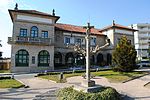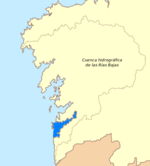Coruxo FC
1930 establishments in SpainAssociation football clubs established in 1930Football clubs in Galicia (Spain)Sport in Vigo
Coruxo Fútbol Club is a Spanish football club based in the parish of Coruxo, Vigo, in the autonomous community of Galicia. Founded in 1930 it plays in Segunda Federación – Group 1, holding home matches at O Vao, with a capacity of 1,500 spectators. The association also has its own futsal section, amongst others. In December 2010 Óscar Pereiro, a former Tour de France winner, joined the club after retiring from cycling and appeared for its reserves.
Excerpt from the Wikipedia article Coruxo FC (License: CC BY-SA 3.0, Authors).Coruxo FC
Camino Canido, Vigo Coruxo
Geographical coordinates (GPS) Address Nearby Places Show on map
Geographical coordinates (GPS)
| Latitude | Longitude |
|---|---|
| N 42.196083 ° | E -8.791757 ° |
Address
Campo de fútbol do Vao
Camino Canido
36331 Vigo, Coruxo
Galicia, Spain
Open on Google Maps









